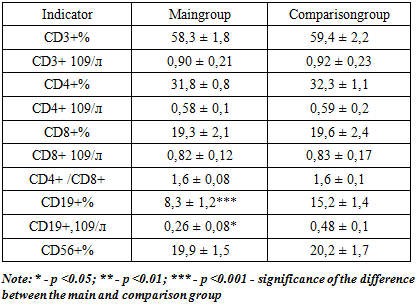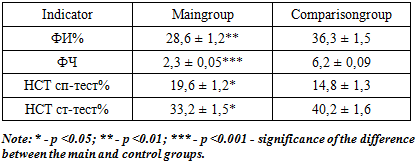-
Paper Information
- Previous Paper
- Paper Submission
-
Journal Information
- About This Journal
- Editorial Board
- Current Issue
- Archive
- Author Guidelines
- Contact Us
American Journal of Medicine and Medical Sciences
p-ISSN: 2165-901X e-ISSN: 2165-9036
2020; 10(6): 397-399
doi:10.5923/j.ajmms.20201006.10

Immunological Mechanisms of Development of Complicated Forms of Atopic Dermatitis
M. R. Xudayberganov, M. R. Mirzoyeva, A. G. Ganiev, K. D. Nazarov
Urgench Branch of Tashkent Medical Academy Andijanstate Medical Institute Uzbekistan. Bukhara State Medical Institute Named after Abu Ali Ibn Sina Ministry of Health of Uzbekistan
Copyright © 2020 The Author(s). Published by Scientific & Academic Publishing.
This work is licensed under the Creative Commons Attribution International License (CC BY).
http://creativecommons.org/licenses/by/4.0/

Examination of 32 children with atopic dermatitis, complicated by staphylococcal infection. Revealed violations of B-cell, humoral immunity and phagocytic activity of neutrophils. The revealed violations of immunological parameters in children suffering from atopic dermatitis complicated by staphylococcal infection are the basis for the appointment of immunomodulators as part of complex therapy aimed at stimulating the B-cell and humoral immunity, as well as the phagocytic activity of neutrophils.
Keywords: Atopic dermatitis, Immunology, Complications
Cite this paper: M. R. Xudayberganov, M. R. Mirzoyeva, A. G. Ganiev, K. D. Nazarov, Immunological Mechanisms of Development of Complicated Forms of Atopic Dermatitis, American Journal of Medicine and Medical Sciences, Vol. 10 No. 6, 2020, pp. 397-399. doi: 10.5923/j.ajmms.20201006.10.
1. Introduction
- In recent years there has been a significant increase in the frequency of atopic dermatitis in children, a pronounced tendency to recurrence, chronic process and resistance to the therapy [5]. Currently, in conditions of environmental trouble, irrational use of glucocorticosteroids in patients with atopic dermatitis, there are often secondary bacterial complications [2,3,4]. In the development of complicated forms of this pathology, an important role belongs to immunological disorders [1,6,7,8]. Therefore, the characteristic disorders in the immune system with atopic dermatitis are a kind of diagnostic criterion and reflect the depth of the lesion.Objective: to study the immune disorders in atopic dermatitis, complicated by secondary staphylococcal infection in children.
2. Materials and Research Methods
- A comprehensive immunological examination of 32 children with atopic dermatitis complicated by a staphylococcal infection was performed. The comparison group included 35 children with uncomplicated course of atopic dermatitis. There were no statistically significant differences in the compared groups by sex, age, and severity of the course. Comprehensive immunological examination included assessment of cellular immunity parameters: absolute and relative T- (CD3 +) and B-lymphocytes (CD19 +), T-helper cells (CD4 +), T-cytotoxic cells (CD8 +), natural killer cells (CD56 +), ratios CD4 + / CD8 +, humoral (IgA, IgG, IgM, CIC), neutrophil phagocytic activity (phagocytic index, phagocytic number, spontaneous and stimulated NBT-test). Evaluation of cellular immunity was performed using monoclonal antibodies (MCAT) to various CD-antigens using flow cytofluorimetry. The content of immunoglobulins a, M, G (IgA, IgM, IgG) in blood serum was assessed by the conventional method of ELISA monospecific sera of MonobindInc (Germany) (TsNIL AGMI and diagnostic center "Farm StandartLyuks").For the study of neutrophil phagocytosis, nitro-blue tetrazolium reduction reaction (NBT-test) was used. We used the technique of Viksman M., Mayansky A.N. (1983). Spontaneous and stimulated NBT-test was determined (the stimulator was used - Ser. Marsecceus vaccine. To determine the phagocytic activity of neutrophils, a suspension of Staphilococcus aureus was used with counting the phagocytic index (percentage of phagocytic neutrophils) and phagocytic number (the average number of microorganisms absorbed by one FFG (average number of microorganisms absorbed by a single object).
3. Results and Discussion
- Mean values of immunological parameters in the examined group, comparison group and control group were determined. immunological examination showed that in children with atopic dermatitis complicated by a staphylococcal infection, in comparison with the comparison group, deeper changes in the indices of B-cell and humoral immunity, as well as neutrophil phagocytic activity, were revealed. Analysis of the data of the complex immunological examination showed that in children with atopic dermatitis complicated by staphylococcal infection, in comparison with the comparison group, deeper changes in the indices of the B-cell and humoral parameters of the immune system, as well as neutrophil phagocytic activity were revealed. The study of indicators of cellular immunity (Table 1) did not reveal significant differences between the main group and the comparison group,? P> 0.05. Whereas, the relative (p <0.001) and absolute (p <0.05) number of CD19 + -B lymphocytes in children with atopic dermatitis complicated by a staphylococcal infection is significantly lower than with uncomplicated forms of the disease. In general, in patients of the main group, a decrease in the total number of B-lymphocytes was observed in 67.8% of cases.
|
|
|
 Abstract
Abstract Reference
Reference Full-Text PDF
Full-Text PDF Full-text HTML
Full-text HTML

